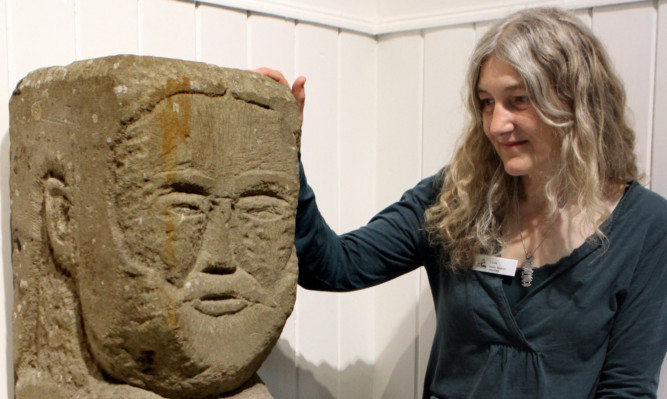Today sees a milestone in the effort to spread the word of an “outsider artist” who spent most of his life in Angus.
The life and work of Adam Christie, Shetlander and patient at Sunnyside psychiatric hospital, will be celebrated in an exhibition for the first time in Montrose Museum. Christie came to Sunnyside Hospital in 1901 at the age of 32 with severe depression, died there in 1950 and was buried in a pauper’s grave in Montrose.
He carved stone faces and figures with a six-inch nail and an old file, made fiddles from tea chests, painted and wrote poetry.
The late Ken Keddie, a consultant psychiatrist at Sunnyside in the 1970s, researched Christie for his book, entitled The Gentle Shetlander, and found celebrated Montrose sculptor William Lamb had taken Christie under his wing.
Museum curator Rachel Benvie said of Christie: “He had been pretty much forgotten although there were people around the Montrose area and associated with Sunnyside that remembered him, or knew of him. His family are still in Shetland.
“The display itself is maybe more important because it ties in to what is now beginning to be called ‘outsider art’.
“That is a really important facet of Christie’s work, using found materials and not being what you’d generally find in an art gallery.”
Christie’s sculpted stone heads were famous in his lifetime and examples are now held in the collections of museums in Montrose, Shetland and Glasgow.
He used whatever stone was available and worked with six-inch nails as chisels, broken files as hammers and pieces of broken glass for sandpaper.
He also painted using discarded tins of paint and old flour bags as canvasses.
The Montrose exhibition, entitled For the Maker’s Own Delight, looks at Christie’s work as an example of outsider art.
A series of panels explores his life and art, while the exhibits have been drawn from as far afield as Shetland as well as the former gardens at Sunnyside and many local people.
Christie was involved in the creation of a plaque in Hillside that commemorated the place where Robert Burns stopped to water his horse in 1787.
Musician and researcher Dave Ramsay discovered that the plaque was the work of four men Joseph Harris, Willie Herd, C.J. Shaw and Adam Christie who removed stones from the wall and set the memorial, with no permission or ceremony.
A simple sandstone plaque in the wall carries the date September 13 1787, and the date 1930 indicates its original installation.
The foursome went out one night in 1930, removed some stones from the wall and inserted the plaque.
Due to the subterfuge involved, this night defied research until the truth emerged during an interview with former Montrose man Harry Harris.
Mr Ramsay said: “Coincidentally, as a singer/songwriter I had researched the life of Adam Christie and written and recorded a song dedicated to the Gentle Shetlander.
“I was totally amazed when, as a separate piece of research two years later, I uncovered the story of the Hillside plaque.”
The exhibition has been financially supported by the Howe o’ the Mearns Heritage Association, the Friends of the William Lamb Studio, Montrose Rotary Club, Montrose Burns Club and GlaxoSmithKline.
The museum opens Tuesday to Saturday, from 10am to 5pm, and admission is free.
